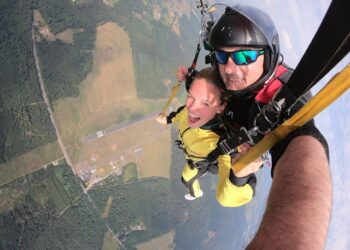Learn about indoor skydiving weight limit, safety policies, gear requirements, and tips for plus-size flyers before entering the wind tunnel.
Indoor skydiving is the perfect mix of adrenaline and accessibility. You get the thrill weather its hang glide or paraglide, of floating in mid-air, all without jumping out of a plane. But before you suit up, there’s one unskippable checkpoint: the weight limit.
And no, this isn’t about body image or judgment. It’s about physics, fan power, and your safety inside the tunnel. Whether you’re 90 pounds or 290, your body changes the entire experience. So let’s cut the fluff and talk specifics.
What You'll Discover:
Is There a Weight Limit for Indoor Skydiving?
Yes. Every professional indoor skydiving facility enforces a maximum weight limit, typically based on:
- Equipment safety ratings
- Airflow control
- Instructor guidelines
- Injury prevention protocols
Let’s start with the big players like iFLY, the global leader in indoor skydiving.
iFLY’s general weight limit is 300 lbs (136 kg). However, most locations strongly recommend staying under 260 lbs (118 kg) for ideal safety and flight control.
Some iFLY centers even list a hard cutoff at 250–275 lbs, especially for first-time flyers.
Why Does the Weight Limit Exist?
1. Tunnel Power and Wind Pressure
The tunnel works by blasting air upward through a mesh floor, creating a powerful vertical wind column. The more mass your body has, the more power is needed to keep you airborne. Exceeding the weight threshold means the fan can’t safely lift or stabilize you, and that’s dangerous.
2. Instructor Safety
Every first-time flyer is accompanied by an instructor, often right beside or gripping your suit. Managing a heavier flyer in that high-speed airspace is physically demanding and risky if you’re not within their training weight range.
3. Equipment limit
Flight suits, helmets, and safety harnesses (for advanced tricks) are designed with maximum load ratings. You need to fit safely within that range for the suit to work properly.
4. Risk of Injury
If a flyer is too heavy for the wind speed available, they might drop unexpectedly, bounce, or collide with tunnel walls. These injuries aren’t common, but when they happen, it’s often due to exceeding safe flight weight.
Typical Weight limit by Indoor Skydiving Facility
| Facility | Weight Limit | Special Notes |
| iFLY (USA/UK/Australia) | 260–300 lbs (118–136 kg) | limit vary by location and instructor comfort |
| Aerodium (Europe, Asia) | 265–290 lbs (120–132 kg) | High-performance tunnels may accommodate more |
| Windoor (Spain) | 265 lbs (120 kg) | Pre-flight screening required |
| Indoor Skydiving Germany | 250–275 lbs (113–125 kg) | Strict enforcement |
| Gravity Bahrain | 265–280 lbs (120–127 kg) | Case-by-case basis |
Always check with your chosen tunnel before booking, especially if you’re close to the upper limit.
What If You’re Over the Weight Limit?
It doesn’t always mean “no.” But it does mean you’ll need to talk directly to the center. Some options include:
- Scheduling a private session where airflow can be adjusted just for you
- Flying with a senior-level instructor trained in handling larger body types
- Advanced booking approval, rather than walk-in flights
Still, don’t show up and hope for the best. Every location reserves the right to deny your flight if your weight compromises tunnel safety, even if you have a booking.
What About the Minimum Weight?
There’s also a lower weight threshold, especially for kids.
Most facilities require:
Minimum age of 3 and minimum weight of 35–40 lbs (16–18 kg)
Why? Because smaller bodies may be too light to stabilize, causing erratic movements in the tunnel. They can bounce too easily or become unstable even with gentle airflow.
Is There a Weight Surcharge?
Unlike outdoor skydiving (where heavier jumpers often pay more), indoor skydiving generally doesn’t charge extra, it’s either within the limit or not allowed.
That said, private sessions or custom airflow accommodations might cost more.
Flying as a Plus-Size Flyer: What to Expect
Here’s what to know if you’re approaching the upper limit but still within range:
1. Expect a Weight Check
You may be weighed, privately and respectfully, especially if your weight seems close to the limit.
2. Suit Sizing Matters
Flight suits go up to 4XL or higher, depending on the facility. If you’re concerned, call ahead to ensure they have a suit that fits your body type properly.
3. More One-on-One Time
Larger flyers may receive extra coaching on body positioning. The airflow reacts differently with more surface area, and the instructor may need to adjust their hold style.
4. Shorter Initial Flight
Your first flight may be kept shorter (30–45 seconds per round) to minimize fatigue and ensure control, with the option to extend based on performance.
Is Indoor Skydiving Safe for Heavier Flyers?
Yes, if you’re within the approved range and follow instructions.
Thousands of plus-size people fly every year without issues. But here’s what you can do to keep your experience smooth:
- Stay centered: Learn to spread your limbs and balance your core early.
- Don’t resist the wind: Relax and let the airflow do the work.
- Listen closely: Your instructor’s hand signals and guidance are crucial.
What If I’ve Had Surgery or a Medical Condition?
If you’re above 230 lbs and have a history of:
- Joint issues (knees, shoulders)
- Recent back surgery
- High blood pressure
- Vertigo or dizziness
…you’ll likely be asked to provide medical clearance or sign an enhanced waiver. Safety first, always.
Pro Tips for Indoor Skydiving Success (at Any Size)
- Arrive early to get comfortable with the gear and instructors.
- Wear fitted clothes under your flight suit, bulky layers reduce flexibility.
- Empty your pockets, phones, jewelry, or wallets are not tunnel-safe.
- Hydrate and rest beforehand, avoid flying on a full stomach or zero sleep.
- Be honest on forms, especially regarding weight or health concerns.
Indoor Skydiving vs Outdoor Skydiving: Which Has Looser Weight Rules?
Neither is “easier”, but indoor skydiving tends to be more accommodating and less risky overall for heavier flyers. Why?
- No parachutes or tandem instructors strapped to you
- No high-speed landings
- Easier adjustments to airflow based on individual weight
That said, outdoor skydiving centers may accept higher maximum weights with specialized gear, up to 300 lbs, in rare cases.
So the winner depends on your goals: ease and accessibility (indoor) vs. authentic freefall from altitude (outdoor).
Key Takings
- Indoor skydiving weight limit typically range between 250–300 lbs, depending on the facility.
- Indoor skydiving weight limit are based on airflow physics, gear safety, and instructor handling, not appearance.
- You may be weighed, and you must fit into proper safety gear to fly.
- Contact your chosen tunnel in advance if you’re near or over the limit.
- Suit sizing, wind pressure, and tunnel size all impact your flight experience.
- Medical conditions or surgeries may require a doctor’s note or clearance.
- Lighter flyers must also meet minimum weight thresholds (usually 35–40 lbs).
- Indoor skydiving is a powerful, safe experience, especially when expectations align with reality.





